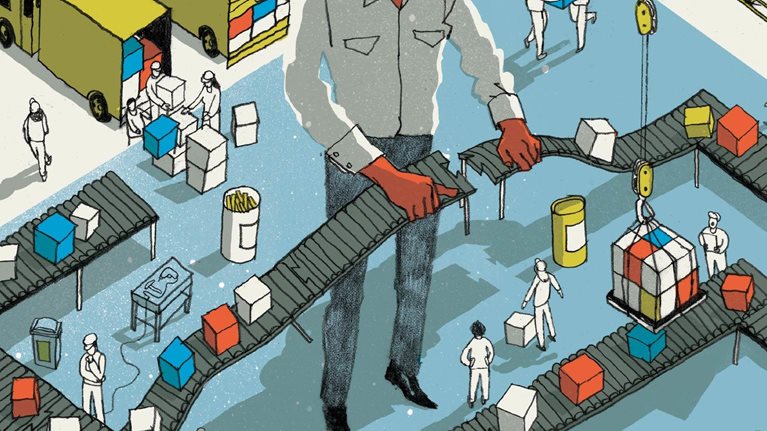The manufacturing of pharmaceuticals and medical devices is becoming increasingly complex. Companies are expanding their product portfolios to meet rapidly changing markets and lengthening product life cycles. Emerging economies want more affordable products. Quality and compliance issues are rising because products are more complex and regulatory scrutiny is stricter. And the number of drug recalls is increasing. Yet the supply chain remains fragmented and incomplete, with weaknesses that put patients at risk, cost billions in value, and lessen the health-care sector’s ability to take on the challenges it faces. (For more, see our video interview with McKinsey director Katy George on how improving the health-care supply chain will benefit companies across the industry.)
The good news is that models do exist to strengthen and improve the health-care supply chain. We believe that by learning from the experience of industries such as fast-moving consumer goods (FMCG), the health-care sector could cut production lead times and obsolescence, while manufacturers, distributors, hospitals, and pharmacies could carry significantly smaller inventories (Exhibit 1). Improving the health-care supply chain also could give millions of people around the world access to safer and more affordable health care, reduce costs, and provide new revenue sources for manufacturers.
Operational metrics suggest huge opportunities.

Our research identified five specific capabilities that can have a dramatic impact on performance and bottom lines:
- better segmentation of products, markets, and customers
- greater agility, to reduce costs and increase flexibility
- measurement and benchmarking
- alignment with global standards
- collaboration across the health-care value chain
Now, we recognize that transforming supply chains isn’t easy. In our experience, limited improvement efforts yield poor results, while comprehensive, integrated efforts are complex. But the payoff can be significant. Supply chains now account for nearly 25 percent of pharmaceutical costs and more than 40 percent of medical-device costs. The annual spending is so vast—about $230 billion on pharmaceuticals and $122 billion on devices—that even minor efficiency gains could free up billions of dollars for investments elsewhere. In fact, if the sector adopted straightforward advances well established in other industries, we estimate that total costs (from the supply chain and external areas, such as patient care) could fall by $130 billion.
Industry research, together with our own experience serving clients, has revealed opportunities to boost profitability throughout the value chain. The improvement from better-performing supply chains would range from about 6 percent for retailers to 20 percent for hospitals and producers of devices and medical supplies (Exhibit 2).
Opportunities from the transformation of supply chains can be found across the whole value chain.

Easing shortages, improving safety
The cost of the shortcomings of today’s supply chain is substantial. Since 2005, drug shortages have nearly tripled in the United States and added more than half a billion dollars in costs for hospitals worldwide. Supply issues also create opportunities for counterfeiters and gray-market vendors, threatening patient safety and cutting into the revenues of legitimate companies. Supply-chain security breaches are increasing by an average of more than 33 percent every year, rising not only in emerging markets such as China, India, and Brazil but also in the developed world.
In addition, medication errors in the developed world occur in roughly 10 to 20 percent of all inpatient hospital admissions. About 1 in 10,000 patients admitted dies from adverse drug events, which, we estimate, add $20 billion to $90 billion in costs to the health-care system globally. Better supply-chain processes are central to increasing patient safety. We estimate that adopting a common global data standard and upgrading supply-chain processes could slash counterfeiting in half, returning $15 billion to $30 billion in revenue (by 2016) to legitimate companies for reinvestment in further improvements to patient care.
Building a new health-care supply chain
A typical Asian laptop manufacturer can accept an order on a Monday and deliver a pallet of freshly assembled customized computers to a European customer little more than a week later. In contrast, a typical pharmaceutical manufacturer has a lead time of about 75 days. How can medical-device and pharmaceutical manufacturers close the gap? Of the five comprehensive transformations we have identified, three can be accomplished internally. Two others—alignment and collaboration—are potentially the most powerful but require a company to work together with its customers, suppliers, and even competitors. Here’s what must be done.
Internal factors
1. Segmentation. Many pharmaceutical and medical-device companies come close to running one-size-fits-all supply chains. In practice, however, there can be significant differences in profitability, value per unit of weight, demand, the importance of a drug or device to patients, a customer’s cost to serve, and service expectations. Forcing products with such varied characteristics through a single set of supply-chain processes creates multiple inefficiencies, such as high inventories for some products while others are in short supply, the use of expensive air freight when slower surface modes would do, or a need to reschedule production campaigns hastily to meet urgent delivery requirements. Leading companies tackle these problems by intelligently segmenting their supply chains according to the characteristics of products and the requirements of customers. They then develop forecasting, production, and distribution strategies for each category.
2. Agility. This means more than just being fast when there’s an emergency; it means building an operating model that can better respond to demand shifts and customer wishes—at the same or even reduced cost. As we mentioned, the replenishment lead time from pharmaceutical plants to distribution centers is 75 days, on average. But leading companies in sectors such as fast-moving consumer goods take a fraction of that time, often without additional investments. Companies must better align the production cycle with the patterns of patient demand and increase the low frequency of their manufacturing processes. The average stock-keeping unit (SKU) is packaged every two to three months; only about 10 percent are packaged every two weeks or less.
An agile supply-chain model also requires stability in production, replenishment, and visibility. Many health-care companies need to make deliveries from third parties and in-house plants more reliable and to upgrade their sales- and operations-planning capabilities to the standards of the fast-moving-consumer-goods industry. The necessary improvements include a more disciplined cross-functional process, a better understanding of demand-and-supply scenarios and of underlying assumptions, more effective communication, and transparency on potential supply issues and bottlenecks.
3. Measurement. Health-care companies need to increase the transparency of their costs, including manufacturing, transport, warehousing, inventory holding, staff, and obsolescence—moves that could cut operational costs and optimize route-to-market approaches and product portfolios. Improvements are also needed in structural drivers or capabilities: responsiveness, manufacturing frequency, reliability of supply, and stability are mostly not systematically measured or managed across the network. Consumer-goods companies are clearly more advanced: they watch metrics such as the manufacturing-frequency index to measure the share of SKUs that are produced with high frequency. Finally, companies must standardize metrics across countries and plants. Commercially available benchmarking tools and approaches provide rough guidance for high-level opportunities in services, costs, and inventories, but not fully comparable results or tangible recommendations on how to capture value.
External factors
While internal optimization can deliver better service at lower cost, companies have even more to gain from optimizing externally. To do so, they must align processes and improve collaboration.
4. Alignment. Manufacturers of fast-moving consumer goods use point-of-sale information from retail customers to build production plans. The grocery industry, for example, has created billions of dollars in value by adopting standard barcodes. To build a cost-effective supply chain, the health-care sector could align around a single set of global standards that support data interchange, processes, and capabilities. Doing so may increase efficiency and patient safety by making it harder for counterfeiters to operate, by reducing medication errors, and by improving recall processes.
5. Collaboration. While the use of common standards is part of the challenge, supply-chain partners must find ways to collaborate more effectively to reap the full benefit. Barriers to improvement are often cultural rather than technical—transactional relationships must be transformed into something more ambitious. In our experience observing successful collaboration projects, six essential steps can make the difference between a productive collaboration and a frustrating one: companies must collaborate in areas where they have a solid footing; agree on sophisticated benefit-sharing models; select partners for the potential value of the collaboration, as well as their capabilities and willingness to act as a team; dedicate resources to the collaboration and involve senior leadership in it; jointly manage performance and measure impact; and start out with a long-term perspective.
At a recent meeting of senior supply-chain executives in the pharmaceutical and medical-device industries, we asked attendees which of these five supply-chain changes offered the greatest opportunity. More than 70 percent specified improved collaboration.
Transforming the health-care supply chain can do much more than improve the bottom line. By embracing the challenge of supply-chain leadership, pharmaceutical and medical-device companies can provide safer, more affordable access to products that enhance or even save the lives of people across the world.
For more on this research, download the full report, Building new strengths in the health-care supply chain (PDF–871KB). You can find further information on the topic of standardization by downloading the related report Strength in unity: The promise of global standards in health care (PDF–3.3MB).


